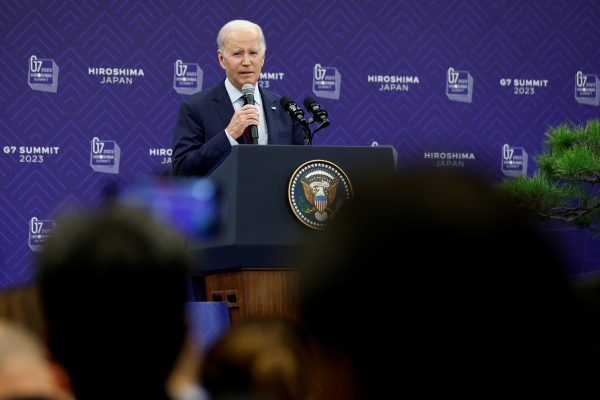During the May 2023 G7 summit in Hiroshima, US President Joe Biden observed that ties with Beijing would ‘thaw very shortly’. Four months later, the United States and China have taken important first steps to put the balloon incident behind them and stabilise their rocky relationship.
Lines of communication have been re-opened, assurances exchanged, working groups formed and incremental forward progress recorded. Progress was made even in areas such as export controls where the two sides had previously clashed. The lack of engagement on their reciprocal tariff hikes and on senior-level defence exchanges remain the key areas where dialogue continues to lag. But even on this latter front, a provisional workaround featuring the Pentagon’s top Asia officials and senior Chinese Foreign Ministry officials has been arranged on more than one occasion.
The proposed meeting between Biden and Chinese President Xi Jinping at the November 2023 APEC summit in San Francisco provides a ‘window of opportunity’ to lock down useful deliverables. Washington should remove the Chinese Ministry of Public Security’s Institute of Forensic Science from its Entity List (a US trade restriction list) in exchange for a crackdown on online vendors of fentanyl precursors by Beijing. The two sides should also amend, update and formally renew their umbrella science and technology agreement — the first agreement to be signed post-normalisation in 1979.
It remains to be seen if the envisaged ‘guardrails’ can survive US election year polemics. But a greater challenge to devising a viable strategic framework for US–China relations is the gap between the two countries’ rival approaches and their perception of the role of neighbouring countries.
The Biden administration’s China strategy has centred on building ‘situations of strength’ with a ‘latticework of alliances and partnerships’ to dictate the terms of competition to China. On the economic front, the US five-pillar strategy aims to pursue an expansive industrial policy at home, work with like-minded partners to build a leading-edge techno-industrial base, move beyond traditional trade deals to new international partnerships, mobilise large sums for global anti-poverty and climate change efforts and protect foundational technologies with a ‘small yard, high fence’ approach. Four of five pillars have no role for or aim to decouple from China.
Having assembled bespoke coalitions such as the Quad, AUKUS, the Indo-Pacific Economic Framework for Prosperity and the US–Japan–South Korea trilateral framework and thereby shaped the strategic environment around China, the administration now seeks to cement a ‘floor’ under its working relations with Beijing.
In China’s view, the US strategy aims to exclude it economically, isolate it diplomatically, encircle it militarily and suppress its development technologically. Washington’s network of alliances, partnerships and minilateral groupings are also seen as an accelerant of major power conflict — not a building block for deterrence and stability.
China faces a delicate balancing act. The primary external ballast of its modernisation strategy — an enabling international environment backed by dense trans-Pacific trade and technology exchanges — has shifted to its disfavour ever since the Trump administration labelled China a revisionist power and unleashed a trade and technology war.
China’s preferred economic counterpart today, the European Union, views Moscow — China’s most important geopolitical power — with repellence. It views Beijing, by extension, with disquiet. Balancing these two relationships to its advantage while simultaneously working out guiding principles to steer China–US ties towards peaceful coexistence is the essence of Beijing’s dilemma.
The United States and China hold discordant views regarding their interests, terms of engagement and conceptions of order. With the on-going rearrangement of the Indo-Pacific’s strategic furniture, a ‘structure of peace’ that features a predictable network of rules and relationships among major powers is unlikely to emerge. A stable equilibrium will not come from a clash of rival interests, and the administration’s canvassing of ‘on demand’ cooperation on one-sided terms will not leaven the underlying tendencies.
Going forward, it is crucial for Washington and Beijing to candidly share their divergent perspectives within a steadying framework. The ambition should be to craft overarching principled understandings – howsoever incredulous each sides’ assurances might appear at first blush to the other – and embed them over the passage of time in their conduct of relations. Both countries should do this with good faith that maintains consistency between words and deeds. Common actions could flow from these shared convictions.
‘Five noes’ were tendered by President Biden during his virtual meeting with President Xi in November 2021 and reiterated in Bali a year later. The United States ‘does not seek a new Cold War, does not seek to change China’s system, does not support Taiwanese independence, does not seek conflict with China and does not direct the revitalisation of its alliances at China’.
President Xi reciprocated with ‘three noes’ in Bali — China ‘does not seek to change the existing international order or interfere in the United States’ internal affairs and has no intention of challenging or displacing the United States’. These principles provide a judicious and steadying framework for future-oriented ties.
Like the Nixon–Brezhnev ‘Basic Principles’ agreement of 1972 that facilitated productive cooperation in exchange for restraint and moderation, the two presidents should memorialise their ‘noes’ in a joint statement.
Washington and Beijing should lock down near-term deliverables at the San Francisco APEC Summit. They should also seek to lessen the gap between their rival approaches by committing to a revamped relationship founded on these principled understandings in this new era of strategic competition.
Sourabh Gupta is a Senior Fellow at the Institute for China–America Studies in Washington, DC.

